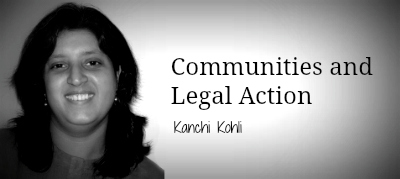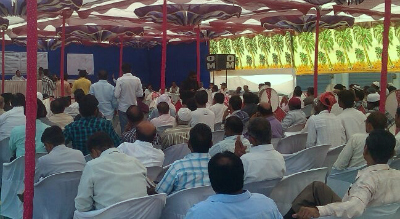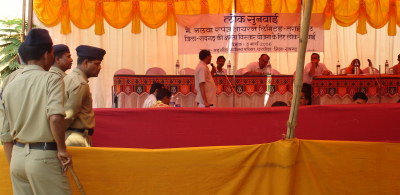 A stage with five chairs was set up some distance from an area where the crowd could assemble. A bamboo barricade demarcated the ‘official’ and ‘public’ spaces. Anyone from this crowd could address the five dignitaries who would preside over the events of the next few hours using a microphone set up near the barricade on the side of the public. Police functionaries surrounded this tented arrangement and a clerk was parked at an adjoining table on the official side. People could approach him through a fenced route and hand over their documents and other submissions.
A stage with five chairs was set up some distance from an area where the crowd could assemble. A bamboo barricade demarcated the ‘official’ and ‘public’ spaces. Anyone from this crowd could address the five dignitaries who would preside over the events of the next few hours using a microphone set up near the barricade on the side of the public. Police functionaries surrounded this tented arrangement and a clerk was parked at an adjoining table on the official side. People could approach him through a fenced route and hand over their documents and other submissions.
Soon, men of stature filled the chairs on the stage. The member of legislative assembly (“MLA”) of the region and the District Magistrate (“DM”) sat next to each other. Two men, who seemed to be ones with a sense of purpose, joined them. One of them wore a well-creased shirt and another carried a bulky set of reports and maps. These two also looked the most stressed. Finally, there was a representative from the state pollution control board, who wore a very visible “been there, done that” expression.
 After the DM opened the proceedings, the MLA took the mike. He declared that the proposed hydropower project was not just a progressive step for the economic development of the people of his constituency; it also allowed them to participate in a national drive for energy generation. He declared in no uncertain terms that he is an ally of the proponent of the project, who would be explaining their project design to all present at this public hearing.
After the DM opened the proceedings, the MLA took the mike. He declared that the proposed hydropower project was not just a progressive step for the economic development of the people of his constituency; it also allowed them to participate in a national drive for energy generation. He declared in no uncertain terms that he is an ally of the proponent of the project, who would be explaining their project design to all present at this public hearing.
Soon after, two trucks arrived, filled with people who walked straight to the clerk. With thumb impressions and signatures, they not only marked their presence but also recorded their approval for a large dam and powerhouse to be built around their homes, fields, and forests. This happened even before the man in the creased shirt had initiated an explanation of how much land the project would acquire, how much forest would be cut, and whether the homes and livelihoods of people will be displaced.

But eventually, their presentation did get underway. It was followed by objections and suggestions from around fifty people. Some raised issues of displacement, others said they did receive documents in time, and many others were concerned about the cultural pollution that would be caused by an influx of labour. After about four hours, the DM called the meeting to a close, without reading out the minutes of what had transpired, something he was required to do.
This story is familiar to anyone who has attended a public hearing under the Environment Impact Assessment Notification, 2006 (“the EIA notification”). Public hearings such as this one are a mandatory third step of the procedure for dams, mines, industries, and ports to receive environment clearance. It is part of a larger process of public consultation , which includes both written submissions and such face-to-face deliberation with the authorities, project proponents, and consultants.
Violations of procedure
The public hearing I have described was ridden with violations of the legal procedure required by Appendix IV of the EIA notification. Community-based organisations, legal researchers, lawyers, and activists have been pointing out these concerns ever since this process was first introduced by an amendment to the 1994 EIA notification in 1997. Today, public hearings are to be conducted “in a systematic, time bound and transparent manner ensuring widest possible public participation” (Section 1 of Appendix IV). Barricading the public hearing space, the MLA making opening remarks in favour of the project, and the presence of police are all intimidating to say the least and clearly deter people from openly speaking their mind. There are also, as I have stated above, clear violations of the legal procedure.
The MLA sitting on the dais, for instance, violates the requirement in Section 4 of Appendix IV that the panel of the public hearing will comprise only of the DM or their representative along with someone from the Pollution Control Board. The MLA’s presence therefore, is reason enough for the illegality of the public hearing.
Another problem with the events described above is that people indicated their consent for the project even before the project authorities had presented a description of the project and a summary of the EIA report. It was as if none of the people who arrived in the trucks were even interested in understanding the impact of the project. It will not surprise those who know how public hearings are conducted across the country that they had been possibly “brought in” to record their attendance in favour of the project. The DM allowed people to sign their consent and leave without really engaging with the project proponents, consultants, or government representatives, which is what the spirit of the public hearing and the procedure laid out in Appendix IV require.
Opportunity to review the draft EIA report

Among the fifty people who opposed the project, one had highlighted the problem that the project documents were not available the public hearing. The EIA notification (Section 2.2 of Appendix IV) requires that both hard and soft copies of the draft EIA report have to be available at designated locations – the offices of the DM, the Zila Parishad or the Municipal Corporation, the District Industries Office, and the regional office of the Ministry of Environment and Forests – thirty days before the public hearing takes place. A summary of the EIA has to be made available, both in English and in the local language of the place where the project is being set up.
This brings us to a fundamental flaw in the design of the public hearing process after 2006 when the EIA notification was amended. During this one-time event, people only have access to a draft EIA report. In the minds of regulators and project proponents therefore, the responses from people are to be used merely to finalise the EIA document. The only relevant comments are those that can be filtered into the final document, or are technical enough for the expert committee to take on board. Based on that they can ask project authorities for additional studies or clarifications.
Restricting the opposition to projects
By restricting itself to ascertaining the “concerns of locally affected people” and those with a “plausible stake in the environmental aspects of the project” (Section III (ii) of the EIA notification), the presiding panel restricts the speaking of anyone who is not local. NGOs, scientists, and activists are often told to make written submissions only. People have of course found creative ways to deal with this problem, with the local community backing them as representatives on technical and legal aspects. Often however, it is up to the DM whether to allow such an intervention or not.
Often, concerns that go beyond being purely “environmental”, go out of the window. When the project comes for appraisal to the MoEF, the reasons that the Minster may record for granting the approval would include the strategic, political, and energy needs of the country. The law however, lands up restricting people’s voices on these very issues.
Public hearings remain one of the most talked about spaces for law in discussions on environment and development. Despite their limitations and despite often being sham events, public hearings make the project authority visible to the community affected by the project. There have been demands that there be more than one hearing, one before the EIA is finalised, and one after. Policy researchers and activists have also demanded that the public hearings be given more teeth. Today, even complete opposition to a project at a public hearing is not decisive. That power lies, with a bunch of technical experts for their recommendation and finally with the minister himself.
Kanchi Kohli (kanchikohli@gmail.com) is an independent researcher and writer.
